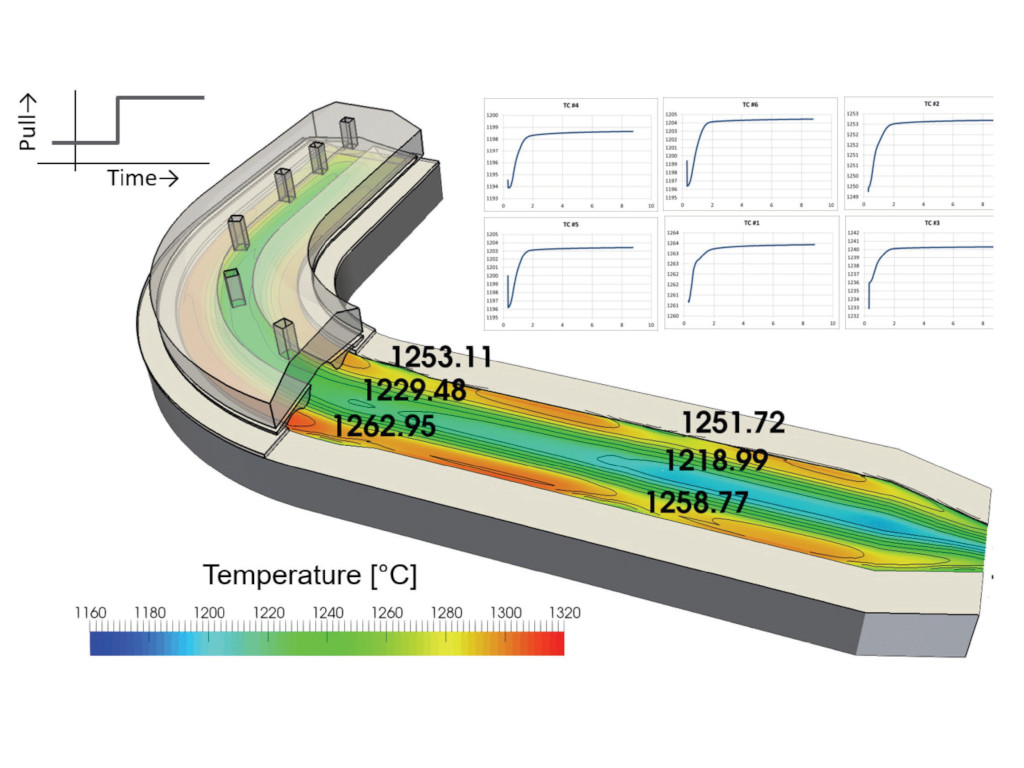Making the decision for a furnace control system can have a big impact on your daily production. To build a traditional model predictive control (MPC) system, the actual running furnace or forehearth is disturbed, leading to undesired process variations and resulting in production losses. Conversely, limiting these losses by making small disturbances results in unreliable control model data.
By using a digital copy of your furnace to generate a control system, there is no impact on your daily production. This method, using a digital copy of the furnace, is called rMPC [the ‘r’ stands for ‘rigorous’]. CelSian’s glass furnace modelling software tool GTM-X generates a digital copy that produces reliable, rapid and ‘rigorous’ results. With this, the company has the ability to perform step responses in-house and build a reliable model predictive furnace control system even before the furnace is operational.
How does it work?
The process starts with the client sending over furnace and/or forehearth design drawings together with furnace data. CelSian uses an online portal that provides guidelines for easy exchange of information and furnace drawings. Information and design drawings provided will be used to build a digital representation of the furnace and/or forehearth. Once complete, this exercise forms the foundation of GTM-X and many of CelSian’s services such as finding design flaws, predicting refractory wear and of course designing an rMPC. GTM-X is more or less a Swiss Army Knife capable of serving many purposes; for example, if there is a glass defect problem that needs to be investigated and resolved and the furnace in question is in our database, CelSian can react quickly, focusing on the specific problem to find the root cause and provide guidelines to overcome the problem in the minimum amount of time.
Let’s go back to rMPC
It is important to understand that if CelSian is involved in checking furnace design during the design stage, most of the work has been already done. Developing an rMPC for the furnace in question will ‘only’ require the final steps: running step responses on the GTM-X model and afterwards, designing the controller. Furthermore, rMPC control will be already operational before the new furnace is fired up – saving a lot of time, operational headaches and money.
How does it interact with traditional process control?
Once in operation, rMPC requires real time process control data such as MVs (manipulated variables) and DVs (disturbance variables) to perform mathematical calculations and, as a result provides refined CV (control variable) setpoints for the traditional PID [proportional integral derivative] controllers running in the process control system. Traditionally, Windows PCs or server systems are used to run the model predictive controller communicating with the process control system via OPC (open platform communications) connections to exchange data. This method remains the same regardless of the type and source of data.1
In principle that all works fine but handing over important process control task to a MS Windows environment is perhaps questionable because it is unlikely that a specific Windows version and the hardware on which it is running will ‘outlive’ a modern process control system and the furnace it is monitoring. It is even less likely that it will be as stable and reliable as the process control system due to the inevitable interruptions from hard- and software updates required by a stand-alone Windows platform.
Today, many process control and DCS [digital signal control] suppliers provide embedded advanced control functionality. They are anticipating that customers require MPC to run their processes safely, reliable and efficiently. These modern process control processors will be able to run complex computations alongside traditional tasks. With this in mind, CelSian has been investigating embedding rMPC into the most common process control/DCS systems. One of these has already proved successful.
Conclusion
Rigorous Model Predictive Control (rMPC) is a well-established technology that supports the glass manufacturing process to become more stable and efficient. Rigorous MPC no longer requires time-consuming on-site furnace disturbances, and provides a reliable advanced control system from the start-up of the furnace. Embedding rMPC into the process control hardware layer will provide the same stable operation as is expected from process control. Integration into HMI (human machine interface) will enable the same look and feel of a traditional process control system. Some process control systems already support this technology by offering a stable embedded rMPC controller.
1 https://en.wikipedia.org/wiki/Open_Platform_Communications


